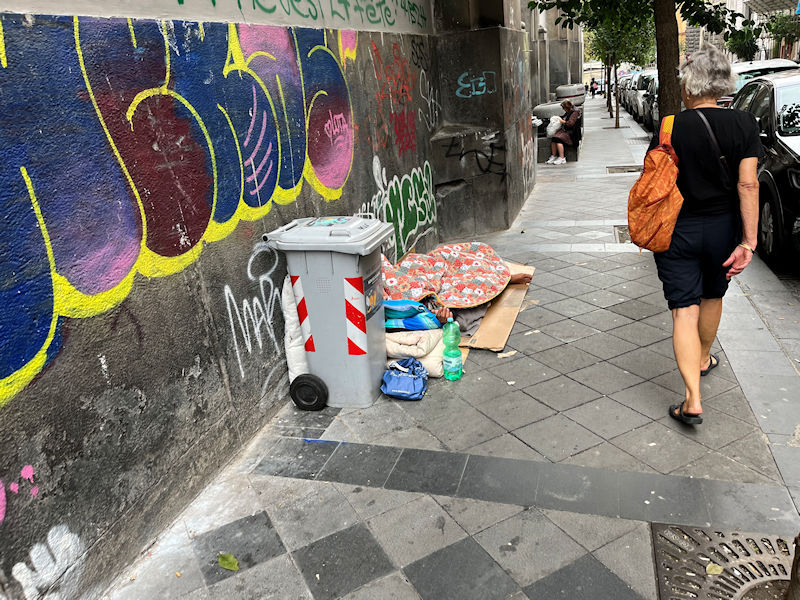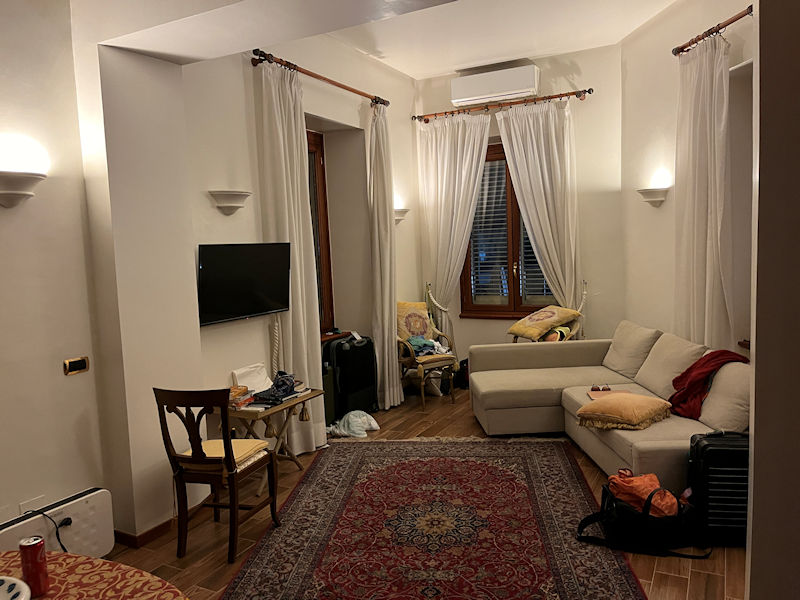You may not find this terribly rewarding unless you're included here, so this is a good time for casual and random browsers to turn back before they get too caught up in the sweep and majesty of the proceedings and can't let go.

The Castel Nuovo in the port of Naples was built from scratch for Charles of Anjou, the brother of King St Louis IX, whom Pope Urban IV had invited down to take over the 'Regno', i.e. southern Italy and Sicily, from the last of the Hohenstaufen dynasty after the death of the Holy Roman Empire Frederick II in 1250. Charles defeated Frederick's illegitimate son Manfred's army in Feb. 1266 at Benevento, six weeks after the pope had crowned him King of Sicily, and sealed that by defeating the troops of Frederick's last heir, 16 year old Conradin, at Tagliacozzo and having the young fellow imprisoned in the Castel dell'Ovo and then beheaded in the new Market Place of Naples.

The Norman leaders in the south had based themselves in the Castel dell'Ovo from 1140 on, at one end of town, but Frederick II Hohenstaufen, when he was in residence, preferred the other main fortified residence, the Castel Capuano (named for the city gate leading out to Capua) at the other end, built by the Norman William I, King of Naples r. 1154-1166, which he expanded. King Charles preferred a larger home base, more central in the city and closer to the port, and with more residential amenities and more modern fortifications; work was begun in 1279 and completed in just three years.
The Castel Capuano lies at the eastern end of the decumanus maximus, the now-pedestrian main street, just 300m past the Duomo. In the 16th century, under the Spanish viceroyship of Toledo, it became the Hall of Jusice, and though altered over time, until recently it was still serving that function.

After a difficult and jumbled century and a half under the complicated Angevin dynasty -- with the rebellion of the Sicilian Vespers (1285), the cultural accomplishments under King Robert (featuring Petrarch, Boccaccio, and Giotto), the problems for Joanna I and the Angevin branches in Hungary and in Provence, and the death of the last of the line, the dissolute Queen Joanna II (d. 1435) -- Alfonso V, King of Aragon, succeeded in his yearlong siege of Naples and entered the city as the new King of Naples and Sicily (as Alfonso I) in February 1443.

Alfonso set about renovating the castle, adding a fifth tower which altered the square Angevin design into a trapezoid, and either he or his illegitimate son Ferdinand, his successor, added this fine Triumphal Arch by 1470. These significant renovations to the castle were carried out from 1453 to 1479.
The castle is, apparently, more commonly called here the 'Maschio Angioino', the Angevin Keep or fortress.

The interior of the castle is based around an enormous parade ground, some 50m x 41m, and this is looking at the entrance of the armory under the top of the stairs, where Roman and other human remains have been discovered, and the stairway leading up to the Hall of the Barons. (The rest off to the left seem to be administrative offices.)

Straight ahead of us is the Cappella Palatina or 'Palatine Chapel', on the side facing the sea, apparently the only surviving Angevin contribution from the 14th century, and under the arcade is the courtyard of the Chapel of the Souls in Purgatory, a 16th century addition by the Spanish viceroys running things by that time.

The admission to the castle generally was either free or very small (ah, memory!), but there is a charge for the guided tour, so we need to pay up in that little office under the arcades and return there at the correct time.
Kicking off the half-century of so-called 'Italian Wars', the French invasion of 1494, in which Charles VIII captured and looted Naples before retreating north, brought the Kingdom of Naples into the hands of Ferdinand and Isabella who ruled Spain jointly. Upon Isabella's death in 1504, Ferdinand of Aragon (d.1516) established what became two centuries of Aragonese Viceroys, some of whom did a great deal of good for the city.

Awaiting our tour guide, we pay a visit to the Palatine Chapel of the Angevins.
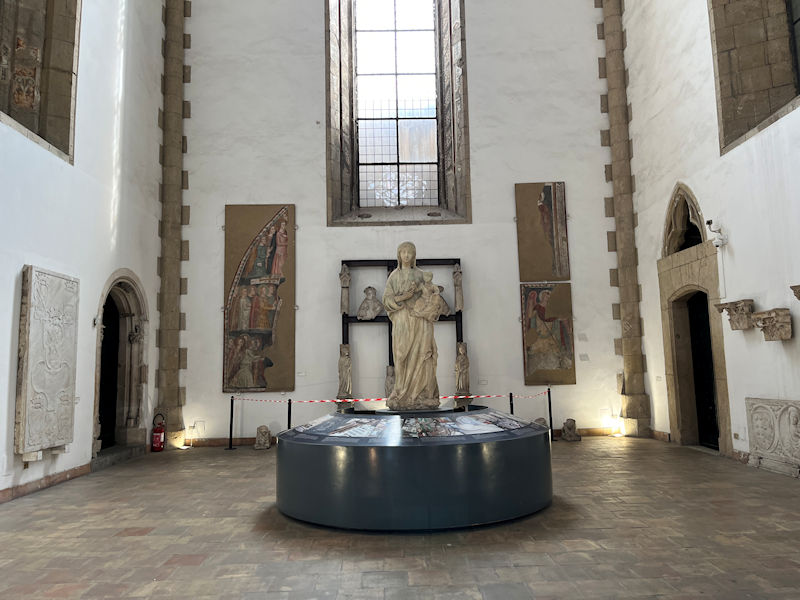
The walls were frescoed by Giotto in the 1330s, but those are virtually all gone now.

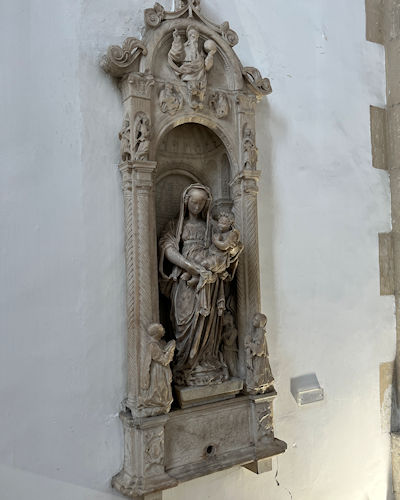
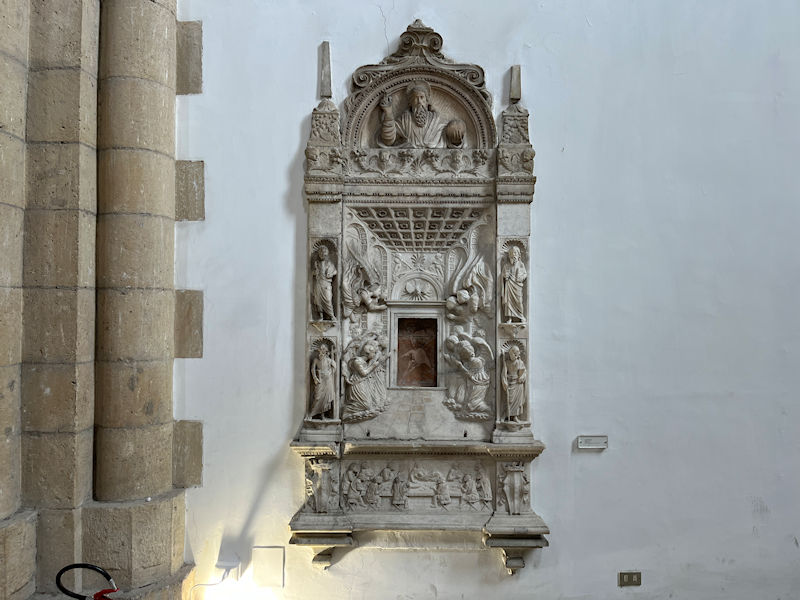
There's a 'Tabernacle with the Madonna and Child' by Domenico Gagini, a Swiss-Italian sculptor, pupil of Donatello and Brunelleschi, who was active in Naples in 1457.

The Chapel of the Souls in Purgatory under the arcade is getting a lot of business, wedding parties assembling in the courtyard festively, entering the chapel, parading out again to make way for another.

The Renaissance entrance portal to the Palatine Chapel is attributed to Andrea dell'Aquila and Francesco Laurana the Dalmatian, both of whom were apparently also working on the Triumphal Arch. The cannonballs are generic.


St Sebastian and St Rocco, by Marco Cardisco, c.1520. These two and one Adoration of the Magi by him are apparently the only paintings that originated here -- the others, here and in the museum we'll see in a few minutes . . .

. . . had all or nearly all 'come largely from church buildings and charities abolished in 1980' (from the info plaque).

'Virgin with St Francis d'Assisi and St Jerome', by Severo Ierace, ca 1530-1540, probably of Naples

A Crucifixion by Antonio Stabile, ca. 1569-1584; the underworld ghoulies are a nice touch.

We're on our walking tour now, and this is a former prison area underneath the Palatine Chapel: the Pit of the Crocodile and the Prison of the Barons. This is the first one, for the more serious prisoners, entitled because of the legends about crocodiles coming in up the water channels and devouring the bad guys. (Alternatively, these could be the ancient Roman remains found archaeologically, of which our guide was also very proud.)

And there are four coffins here bearing what are assumed to be remains of the executed participants in the Barons' Conspiracy.

Speaking of the Barons' Conspiracy, this is the great council hall commissioned by Robert, King of Naples, and originally frescoed by Giotto in about 1330, and then under Alfonso V of Aragon, rebuilt and enlarged by Guillem Sagrera.

This is our exuberant tour group, trying like us to figure out what on earth the tour guide is saying.

The 'Conspiracy of the Barons' was a rebellion against Ferrante I (i.e., Ferdinand I) by the aristocracy culminating in 1485 and 1486, because of his efforts to weaken the feudal bonds and establish authoritarian rule. Eventually, the King declared a truce, made concessions, and invited the barons to a celebratory feast here in this room; once settled in, he had soldiers arrest them all, and some or all of them were executed.
Our tour guide informed us of an interesting aspect that we find mentioned nowhere else, that the King had positioned archers up in those windows reached by a back staircase and had all the barons murdered whilst they were trying to figure out how to get out of the room. How interesting.

Free time after thanking our pretty lame guide, we're up on the roof peeking over some fairly useless defensive merlons.

The merlons on the tower look more authentic, a little more to hide behind whilst reloading your crossbow or whatever. Up on the Vomero hill, that's the Castel Sant'Elmo and the St Martin's Monastery in front of it.
We've seen St Elmo often enough, but we plan to go back to the monastery on this visit.

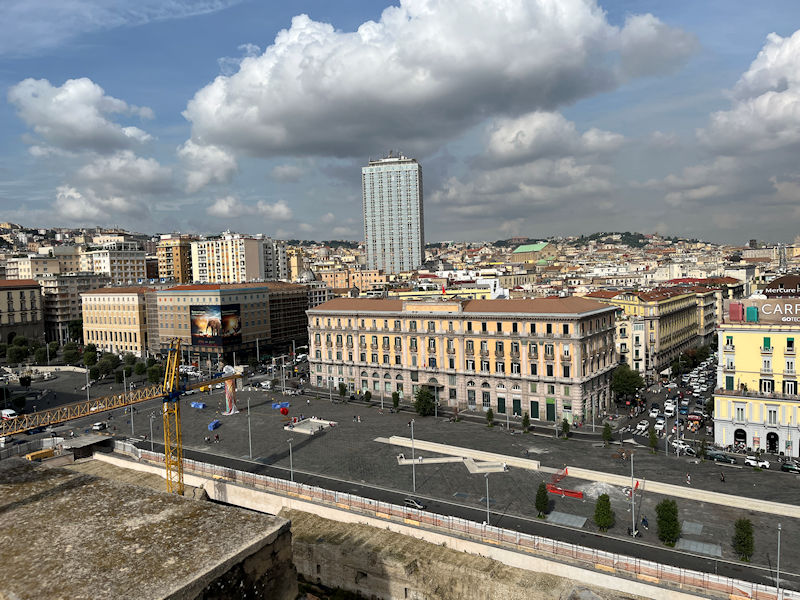
The Piazza Municipio stretching out below us to the north
Now we'll have a look in at the Civic Museum
(recalling that these works have all been taken from abolished churches and charities).

This is the other original work in the collection, the 'Adoration of the Magi', attributed to Marco Cardisco, ca. 1519. The other works here were brought in from former churches and charities, we were told.
Lighting is an issue here: there are sizable windows on both sides of the rooms.

'The return of the prodigal son', by the workshop of Francesco Bassano (1549-1592); this is Francesco dal Ponte (aka Bassano) the Younger, the eldest of four painter sons of Jacopo dal Ponte, working in their native town of Bassano del Grappa and prominently in Venice.

This is just labeled 'Biblical scene', also by Francesco Bassano's workshop. We visited Bassano del Grappa a few years ago, north of Venice, and it's a very fine town that's very proud of its artistic family; the Via Jacopo Da Pont is one of its most attractive shopping thoroughfares.
There was another 16th century Bassano family from Bassano del Grappa, all musicians -- Jeronimo the patriarch moved to Venice as a musician for the Doge, and five of his sons moved to England, probably in 1540, to serve as musicians in Henry VIII's court. The eldest, Anthony Bassano, is recorded as formerly Queen Elizabeth's musician, a foreigner and married with ten children, living in a London parish in 1607.

'Busto reliquiario di Santa Elena', by 'Ignoto' of the 17th century

'Christ and the Samaritan woman', by Luca Giordano 'and help' (e aiuti). Giordano (1634-1705) was a Neapolitan native son who also spent time working in Venice, Florence and elsewhere, and as a court painter in Spain for 10 years, but returned to Naples and worked prolifically to the end.
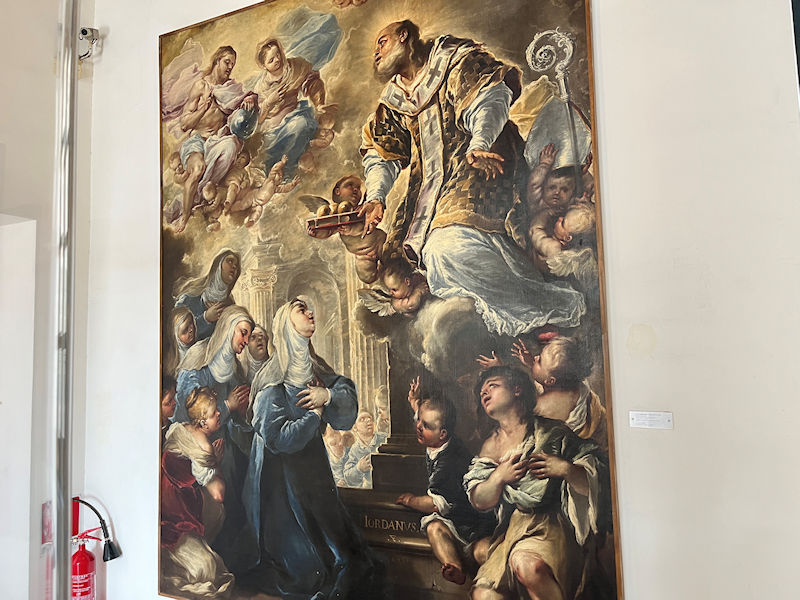
Another by Luca Giordano, 'St Nicholas of Myra in glory' , like most of the pictures in this collection undated.

'The death of St Joseph', by Paolo de Matteis (1662-1728), who was based in Naples except for brief commissions elsewhere.

Another 'Adoration of the Magi', 1707, this by Guglielmo Borremans (1670-1744), a Flemish painter from Antwerp who worked principally in Naples, Cosenza in Calabria, and Sicily.

Discussions with the curator
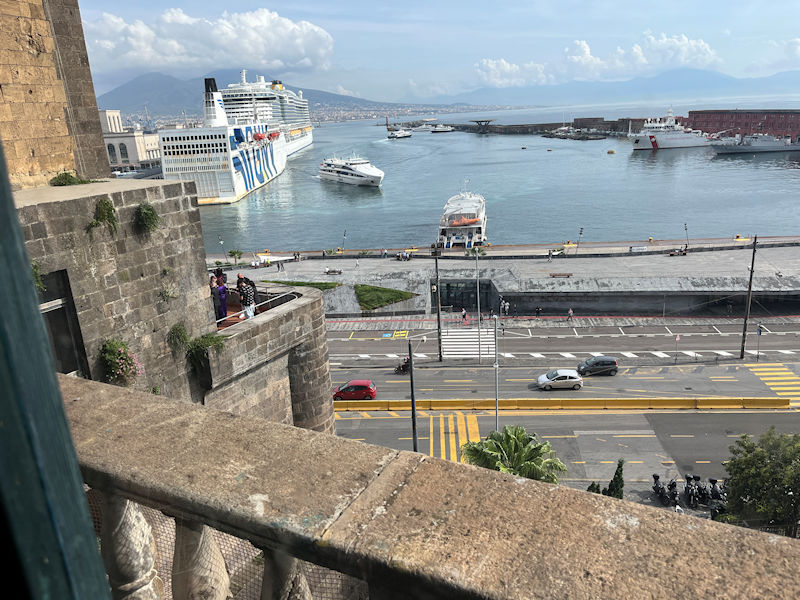
The view from a castle balcony facing the bay

-- Very nice, thanks. We'll be leaving now.
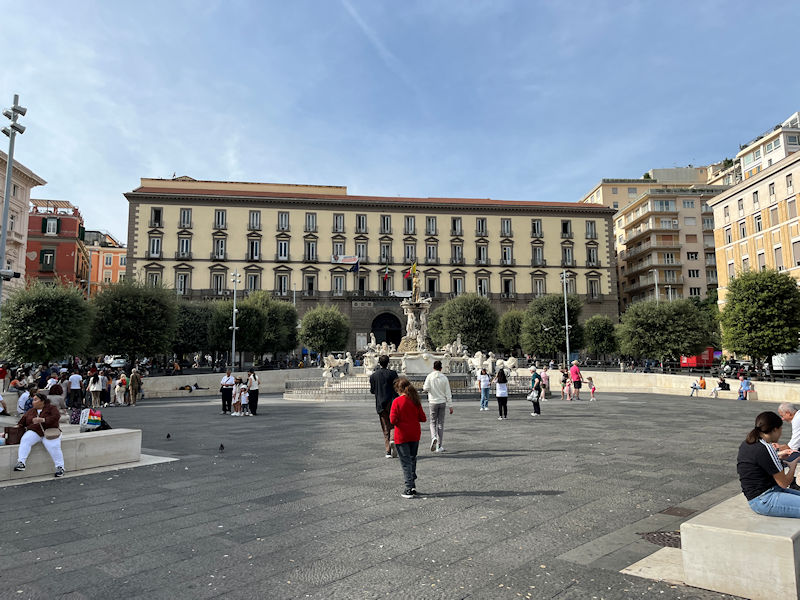
Crossing the Piazza Municipio at the side of the Castel Nuovo, approaching the Fountain of Neptune, made in 1600. We're headed uptown, on a mission.

Two missions, actually. The first is lunch, here at the Pizzeria Dal Presidente in a little piazza off the Via Tribunali, in front of the 16th century Chiesa dei Girolamini.
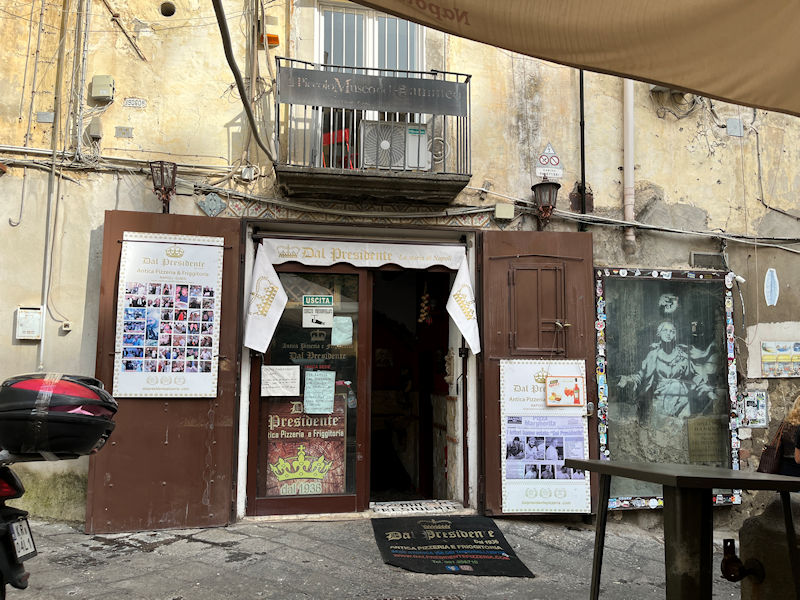
Dal Presidente, and just off to the right . . .

. . . 'The Madonna', an original work by Banksy, 'custodita dalle Pizzeria Dal Presidente'

We venture a bit farther along the Via Tribunali.

We're overshooting a little bit now, across the Piazza San Gaetano in front of the Basilica di San Paolo Maggiore, because in the alley here, as directed by that black sign, there is one of the entrances to the 'Napoli Sotterranea Acquedotto Greco-Romano', a tourist-oriented excursion through the insane underground world beneath Naples. Kristin is interested, and we'll follow up with it another time.
This piazza, by the way, is rumored to be the best centre for pizza restaurants in town.

The Via Tribunali -- we'll be back often over the next week, but in the meantime . . .

. . . here's the Basilica of San Lorenzo Maggiore just off the Via Tribunali and the Piazza San Gaetano.

The San Lorenzo Maggiore is in the middle of a serious refurbishment -- the façade looked just like this at this time last year. In any case, we're at the head of Via S. Gregorio Armeno, where lots of artisans hang out and is a 'renowned strip called 'Christmas Alley''.

We're looking, as usual, for just the right, specific additions to Kristin's crèche or presèpe collection.

The Neapolitans are famous for these handcrafted pieces, everything from Baby Jesuses and Madonnas to baskets of bread, piles of vegetables, tubs of dead fish, the list could be interminable.

The trained eye knows precisely what to look for.

We'll have to dawdle about for a while, this could take some time.
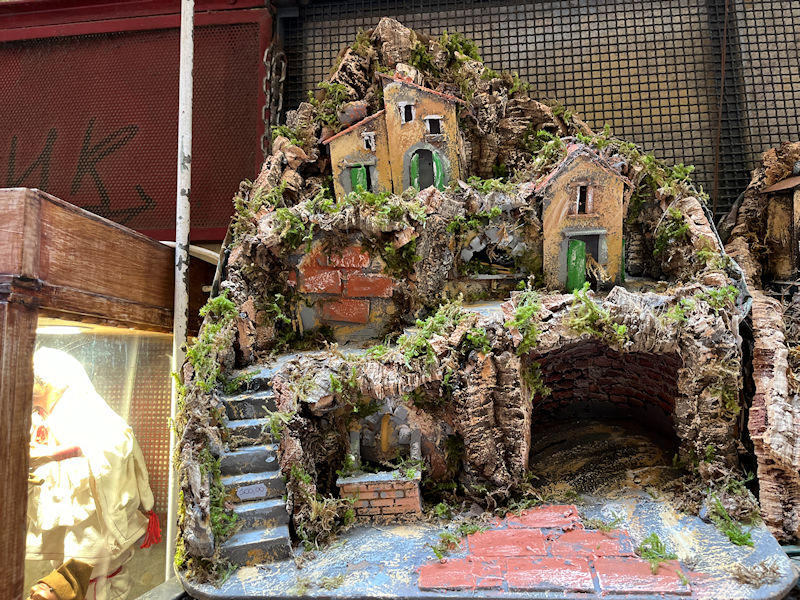
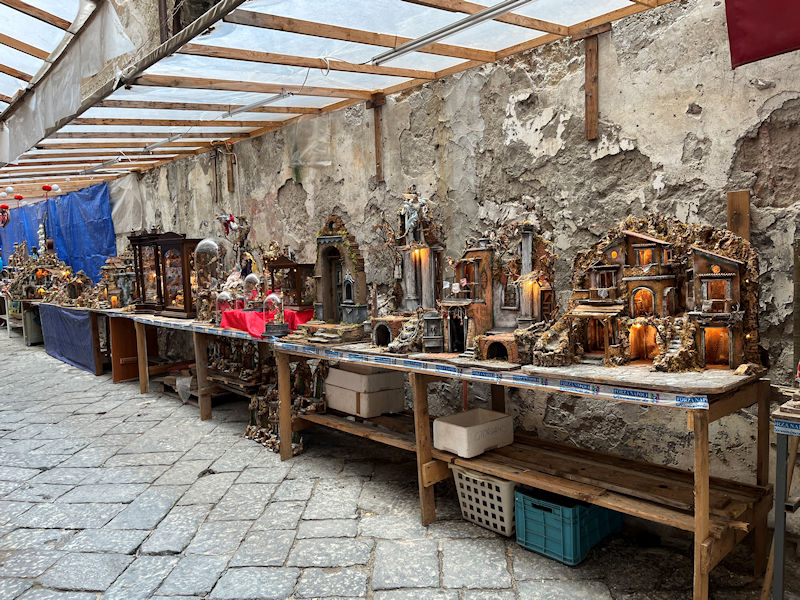
The little Vico Santa Luciella catches some of the overflow.

Unfortunately, we didn't find what's needed this time, but we'll return another day.
The number 10 is a Maradona football shirt; it's a cult in Naples.
 Dwight Peck's personal website
Dwight Peck's personal website
























































